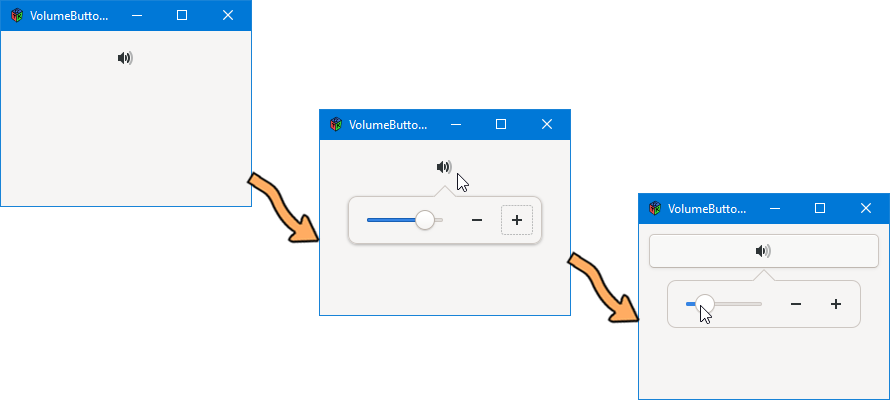0047: The ScaleButton and VolumeButton
Because the ScaleButton is the more involved of these two, I’m going to start with…
The VolumeButton


As with our previous example of the SpinButton, nothing really changes at the top of the file except a couple of import statements:
import gtk.VolumeButton;
import gtk.ScaleButton;
import gtk.Adjustment;
and the class derived from the VolumeButton:
class MyVolumeButton : VolumeButton
{
double minimum = 0;
double maximum = 10;
double step = 1;
Adjustment adjustment;
double initialValue = 7;
double pageIncrement = 1;
double pageSize = 1;
this()
{
double compensateForWinBug = initialValue + 1;
super();
adjustment = new Adjustment(compensateForWinBug, minimum, maximum, step, pageIncrement, pageSize);
setAdjustment(adjustment);
setValue(initialValue);
addOnValueChanged(&valueChanged);
} // this()
void valueChanged(double value, ScaleButton sb)
{
writeln(getValue());
} // valueChanged()
} // class MyVolumeButton
As before, we have to set up an Adjustment object in the constructor, but you’ll notice there’s an extra step.
When we instantiate the Adjustment, the initial value is set to compensateForWinBug which is evaluated as initialValue + 1 and later, it’s set again:
setValue(initialValue);
This is because the Windows version of GTK has a bug that—at runtime—causes the wrong icon to be shown initially when using the ScaleButton or its child, the VolumeButton. And the workaround is to set the Adjustment’s initial value and then change it right away before the user sees it.
Also, because the value of compensateForWinBug depends on the value of another variable, we have to set it inside a function because the compiler won’t know the value of that other variable at compile time.
Anyway, so much for the VolumeButton. Let’s look at its parent…
The ScaleButton


I’m presenting this example second because the ScaleButton needs a set of icons passed in when it’s instantiated. Rather than being a big pain, however, it means we can play around with the icons displayed on the button when various values are set.
Note: You can use the ScaleButton with an empty icon array, but it ain’t pretty.
The obvious set of icons to use is the same one found on the VolumeButton, but after a few minutes of digging in the icon folders, I found some that better suited the purposes of this demonstration. But before we go there
<Reminder Mode: ON>
Icons
Two things to remember…
First, you’ll wanna know where they are. On Windows:
C:\Program Files\GTK3-Runtime Win64\share\icons
or here:
C:\Program Files\GTK3-Runtime\share\icons
On Linux:
/usr/share/icons
Second, the icons used for buttons are the 16x16 set.
<Reminder Mode OFF>
The ScaleButton Class
As before, only one segment of this code file is different (and, truth be told, not all that different):
class MyScaleButton : ScaleButton
{
double minimum = 0;
double maximum = 10;
double step = 1;
Adjustment adjustment;
double initialValue = 5;
double pageIncrement = 1;
double pageSize = 0;
// string[] icons = ["audio-volume-muted", "audio-volume-high", "audio-volume-low", "audio-volume-medium"];
string[] icons = ["face-crying", "face-laugh", "face-embarrassed", "face-sad", "face-plain", "face-smirk", "face-smile"];
// string[] icons = ["face-crying", "face-laugh", "face-plain"];
// string[] icons = ["face-crying", "face-laugh"];
// string[] icons = ["face-plain"];
this()
{
double compensateForWinBug = initialValue + 1;
super(IconSize.BUTTON, minimum, maximum, step, icons);
adjustment = new Adjustment(compensateForWinBug, minimum, maximum, step, pageIncrement, pageSize);
setAdjustment(adjustment);
setValue(initialValue);
// addOnValueChanged(&valueChanged);
} // this()
void valueChanged(ScaleButton sb)
{
writeln(getValue());
} // valueChanged()
} // class MyScaleButton
As with the VolumeButton, we have to set and then reset the initial value so the proper icon is displayed on start-up, but now let’s talk about this icon stuff…
Defining an Icon Set
There are two ways to go about this:
- with a set (read: array) of just two icons:
- the first is used for the lower end of the scale, and
- the second is used for the high end, but
- with three icons:
- the first is used for the minimum setting only,
- the second is used for the maximum setting only,
- and the third is used for everything in between, but-but…
- with four or more icons,
- the first and second are used for minimum and maximum, and
- the rest are spread evenly across the rest of the range.
I left a bunch of different icon sets commented out in the code file so you have something to experiment with.
Conclusion
And there you go, the ScaleButton and the VolumeButton in party hats. Stay happy, keep coding, and see you next time.
Comments? Questions? Observations?
Did we miss a tidbit of information that would make this post even more informative? Let's talk about it in the comments.
- come on over to the D Language Forum and look for one of the gtkDcoding announcement posts,
- drop by the GtkD Forum,
- follow the link below to email me, or
- go to the gtkDcoding Facebook page.
You can also subscribe via RSS so you won't miss anything. Thank you very much for dropping by.
© Copyright 2024 Ron Tarrant
